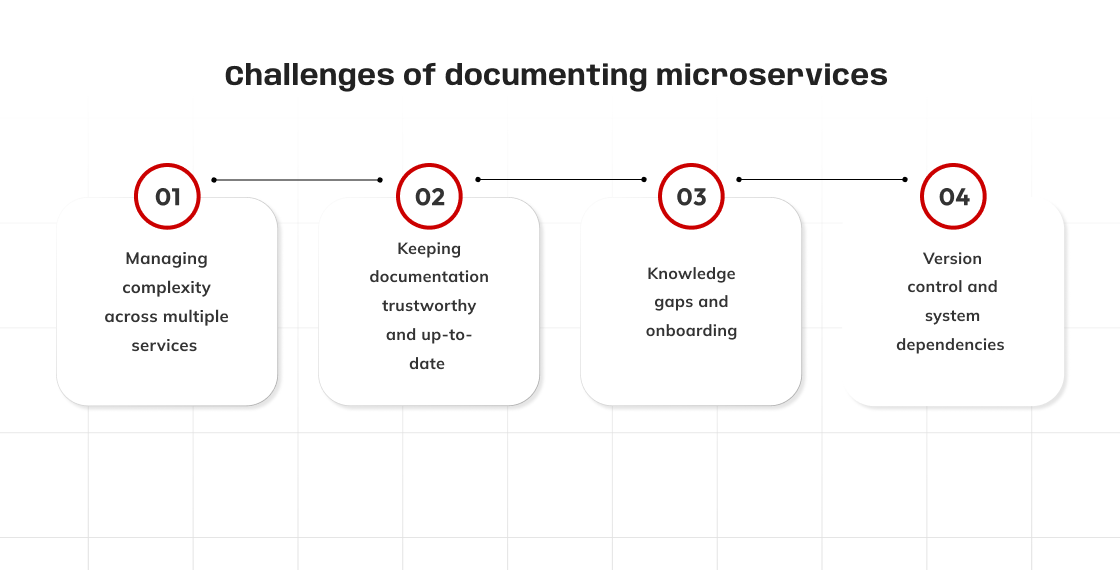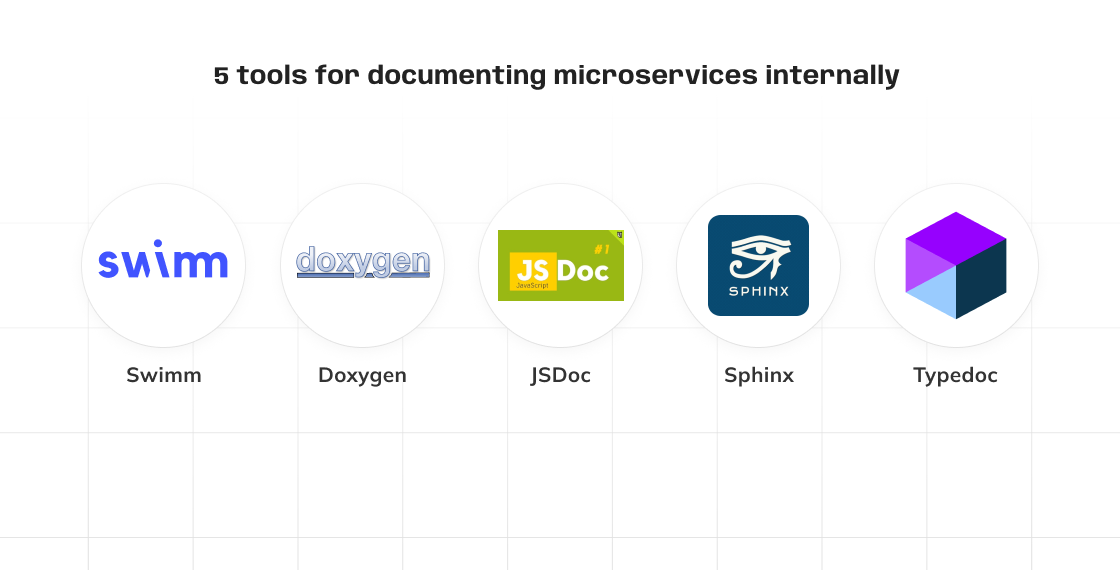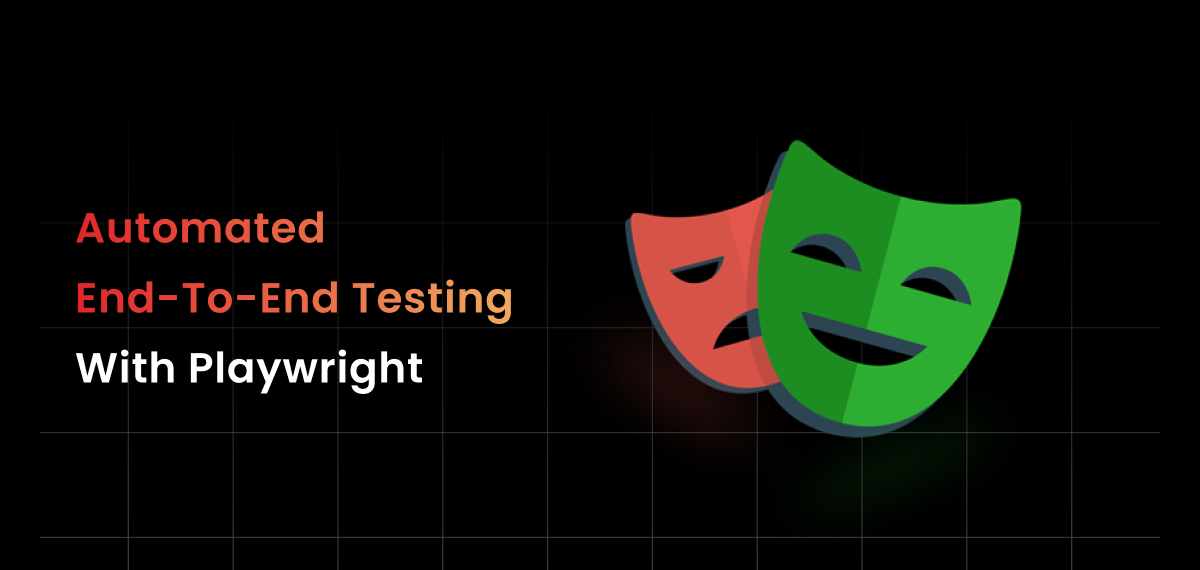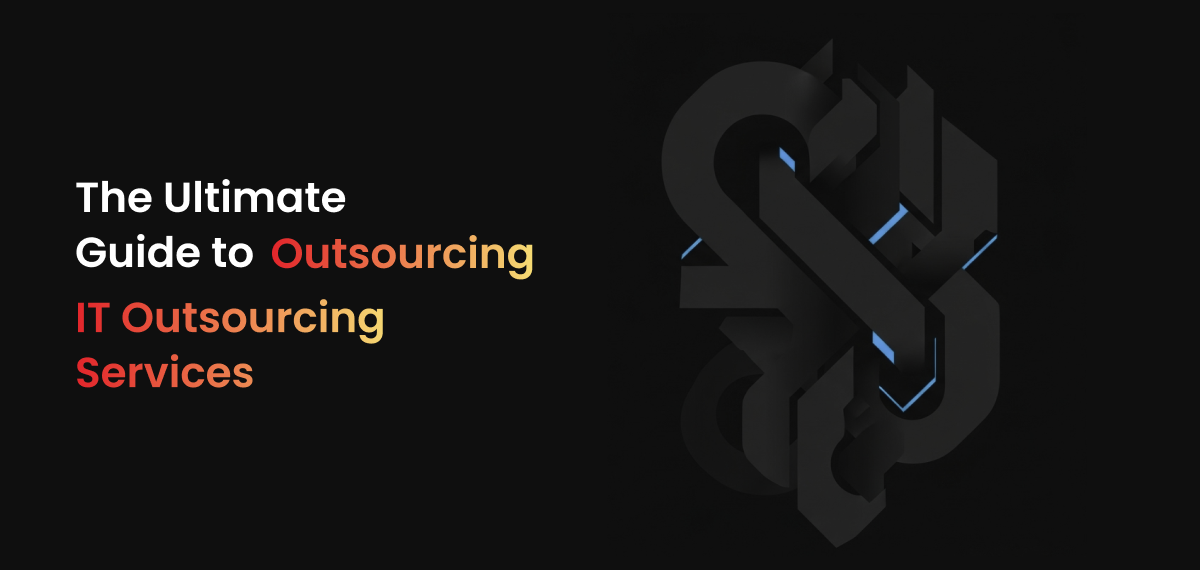Transitioning to microservice architecture from a monolithic one is a daunting task, as there are many pitfalls within which one can find oneself. You may also wonder how your team will handle this change. Failure to document processes and strategies may effectively lead to the loss of important details, which may cause a fuddling effect and hinder progress.
What are the strategies that can be employed to manage such a shift? Here, we discuss the issues of team readiness and cohesion to ensure a smooth transition and successful microservices architecture establishment.
What is the role of documentation in the microservices transition?
Documentation is extremely useful in a case when the organization is changing its software production technology from monolithic architecture to microservices. In a monolith, there is a common codebase where everything is connected and interdependent, however with microservices the application is decomposed into smaller self-containing services. Every one of these services contains its codebase, database, and a particular way of being deployed in the layered application. This is beneficial as it makes the previous over-dependence on one system impossible. However, it makes the system exceedingly complex. Therefore for the good of the system, clear and consistent documentation is necessary to assist everyone in comprehending its working principles, as the parts are so many and independent.
Why is documentation so important?
As it was mentioned above, the team during the transition to microservices should all be on the same page about the behavior of the individual services, how they interact, and their role in the entire system as a whole. It is possible to describe these relationships and give directions on how to navigate through them with the help of documentation. It also informs the developer on how one should create, install and support the particular service. In the absence of proper guidelines, the cohesiveness of the team is put at risk. In the course of the assignment, errors and confusion are often encountered, and the processes take unnecessary long periods there since every member of the team or almost every member has to deliver technical information on how things function instead of building the system.
Supporting knowledge transfer
Switching to microservices implies a great deal of knowledge that has to be moved from the former system to the latter. That is how the legacy code works, which is joined to what part of the application and what new tools and technologies will be employed in the microservices design. Documentation serves to compile all this knowledge in a single place for everybody in the team’s ease of access. This is particularly vital in the case of fresh team members who should acclimatize to the project as fast as possible. Proper documentation guarantees that all persons, without regard to their level of experience with the previous system, know the workings of the ongoing project.
Facilitating cross-team collaboration
Looking at microservices architecture, it is common for different teams to work on different services concurrently without any interaction. Documentation serves to keep these teams in sync – by indicating what each service does and how it is used along with other services. This shared perception helps mitigate the risk of making contradictory adjustments or failing to grasp service interaction entirely due to changes. It also fosters a healthier situation where teams do not have to keep contacting each other trying to explain what they are doing or how things are supposed to work as the teams have the documentation to help understand the works of the other team.
Maintaining consistency and quality
The microservices are small, self-sustaining units of work that tend to change very often and regularly. Because of this dynamic environment, keeping up-to-date documentation is imperative to ensure consistency and quality of all services. Documentation has to include not only the design and implementation of the original system but also to all the changes that will happen in that system over time. This makes certain that each one has the current information parents are always working with, hence preventing confusion and minimizing loss of efficiency within the team.
Record history
The importance of documentation increases as the envisaged growth, change, and development of the microservices architecture takes place. It keeps track of the modifications made, the decisions taken and the rationales for the decisions which is very useful in case of problem resolution or performing changes for the system in future. Properly written documentation encourages you to do more than simply record what was done, but also seek to share why it was done. Such an outlook is crucial to the good evolution of the system with the right level of agility and manageability over time.
Challenges of documenting microservices

When you start to decompose your application into smaller independent services several difficulties can come into play. Not understanding these difficulties would impede coming up with useful documentation.
Managing complexity across multiple services
The issue arises in how to manage system complexity when the design is a monolith i.e. everything is contained in one system, which would be simple to document. Though microservices are very different — each service is separate and does not depend on other services. This means you not only have to document each service but also the relation of all services. In such cases, as many services are working together, the complexity tends to increase and controlling all the complex processes can be nearly impossible without proper documentation.
Keeping documentation trustworthy and up-to-date
This is especially true in situations with microservices. Microservices are known to undergo modifications quite regularly. Functionalities are added, errors are corrected, and services are upgraded at regular intervals. This rapid change makes it very likely that the microservice documentation will fall behind the current development state. Where there is no consistency in keeping the documents up to date, there is a risk of misunderstandings and mistakes since the available information, which the developers rely on is no longer correct.
Knowledge gaps and onboarding
There is a risk of developing knowledge gaps when moving to a microservices architecture. The members who previously worked and understood a monolithic architecture may not easily grasp the concept of microservices. The new members may also find it hard to understand how the different services work independently. In such a case, failure to provide accurate and clear documentation will make the onboarding process very lengthy; and even the seasoned developers in the firm will waste time addressing the same questions that could have been solved from the documents instead of coding.
Version control and system dependencies
Microservices share a lot of interdependence, and hence alteration of any one of the operations will likely cause a ripple effect with the rest. There is a need to record the interdependency, as well as the suitable version of each service. so that There are records in terms of documents also, as to how services as well as versions of services are integrated. This documentation needs to go beyond the services themselves to the services and their interactions and dependencies.
These problems can be identified and remedied, and as a result you can create a suitable documentation plan that will be in place, creating support and comfort, as you tackle the work of migrating to a microservices architecture. Effective documentation minimizes uncertainty, facilitates faster adaptation of new approaches and promotes productivity during the development and support of the microservices-oriented system by the team.
5 tools for documenting microservices internally

1. Swimm
Swimm is a documentation solution that helps to fit in your development environment. With it you will be able to create and update the documentation in relation yto the code and most importantly it is always current. This is of utmost importance especially when following the microservices architecture patterns since most of the services within this pattern tend to change or grow very fast and keeping the up to date documentaion accurate can be a hard task. Also Swimm comes packed with AI that makes it easy for the user to generate documentation from out of an entire repo, a pull request, a branch change.
Why use Swimm for documenting microservices:
- Typedoc is the most appropriate in case your microservices are written in Typescript. It is able to break down the structure of your code with type definitions alongside documentation comments, making it easy for developers to appreciate the detailed aspect of every service.
- Use Typedoc when you have documentation needs where comments are not the only feature included, the types information is also present. This is very important for the management of the documentation in projects with extensive use of Typescript.
- Typedoc is perfect in case you are looking at creating documentation in HTML format where there will be hyperlinks for easy navigation by the developers. This ensures that the team does not face difficulty in understanding how the pieces of code work together.
2. Doxygen
Doxygen is a tool that automatically generates documentation from comments in your source code. It supports a wide range of programming languages, making it versatile for teams working with different technologies. This tool is especially useful in a microservices environment, where each service might be written in a different language and have its own unique codebase.
Why use Doxygen for documenting microservices:
- Doxygen is great when you want to save time by automating the process of creating documentation. Instead of writing separate documents, developers can simply add comments directly in the code, and Doxygen will generate structured documentation based on these comments. This is particularly useful for teams that are short on time or have many services to document.
- Imagining your architecture of microservices in many programming languages Doxygen would work perfectly as it comprises many languages including C++, Java, Python amongst others. This means that it helps make sure that there is no language barrier when it comes to service documenting.
- Doxygen is also of great value especially when, different types of documentation is required. generated documents might include but not limited to html, pdf, latex and many more thus it fit a lot of documentation purposes This is appreciated in the event that the documentation needs to be available in different formats for different audiences and different uses like using it in a developer’s guide, technical documents or training purposes.
3. JSDoc
JSDoc is specialized software that helps document javascript applications. By the use of proper commenting on the source code, software developers will be able to produce clean and comprehensive documentation without much effort. This will be an added advantage in a microservices architecture where several services, most probably written in JavaScript need to be documented.
Why use JSDoc for documenting microservices:
- The use of JSDoc in documenting microservices is logical in case most of the microservices are developed with JavaScript. As it is built within the JavaScript development environment, it becomes possible for program authors to document their work in code concurrently.
- If you’re looking for an easy-to-use application which does not take time to install, then go for JSDoc. It employs standard JavaScript comment to document the code, therefore the developers do not need to master any additional syntax or tools.
- Most of these excuses include the fact that the code in those projects is not static. JSDoc is excellent for any such project as it offers on-screen documentation updates, so you will not have outdated documentation that does not reflect the reality in the code.
4. Sphinx
Sphinx is the documentation generator which was first developed to work on projects in Python but is suitable for more than just that. It constructs beautiful and comprehensive documentation by using restructured Text which is a simplified markup language. Sphinx is great for any groups that want to create excellent internal documents that are easy to adapt and able to fit different formatting requirements.
Why use Sphinx for documenting microservices:
- Sphinx is very beneficial in a situation where the documentation needs may differ based on the respective projects. This is made possible due to the fact that the overall architecture, arrangement and even the appearance of the documentation can be changed making it easy to deal with complex architectures of microservices which prism detailed and specialized documentation.
- If you want to take advantage of sophisticated documentation capabilities such as cross-references and auto-generating index or integration with source code management systems, then Sphinx is an excellent option. These capabilities are important in environments with microservices where services must deal and there is a need to track how they deal with each other.
- Use Sphinx if you require documentation in different types, say HTML for web based materials, PDF for printed use, or ePub for flexible documentation. This aspect of Sphinx makes it appropriate for teams that have varying documentation requirements.
5. Typedoc
Typedoc is a tool highly recommended for software projects written in TypeScript for the creation of documentation. This is done through extracting different attributes such as types and comments, among others, from the TypeScript files and compiling a readable and navigable document.
Why use Typedoc for documenting microservices:
- Typedoc is the most appropriate in case your microservices are written in Typescript. It is able to break down the structure of your code with type definitions alongside documentation comments making it easy for developers to appreciate the detailed aspect of every service.
- Use Typedoc when you have documentation needs where comments are not the only feature included, the types information is also present. This is very important for the management of the documentation in projects with extensive use of Typescript.
- Typedoc is perfect in case you are looking at creating documentation in HTML format where there will be hyperlinks for easy navigation by the developers. This ensures that the team does not face difficulty in understanding how the pieces of code work together.
Legacy code migration to microservices
Several advantages await modern-day enterprises if they consider moving from a monolithic to a microservices architecture. When intoducing microservices into existing systems, however, technical debt in the form of legacy code must often be addressed. The legacy code present in that system can be quite old, contain little or no guidance concerning its usage, or be intertwined with various other system components, making it challenging to disentangle, if not impractical. In order to overcome such challenges, the risks associated with them must be mitigated by establishing controls and processes such as proper documentation and sharing of knowledge among persons involved in the transition.
Understanding legacy code challenges
Legacy systems do not have microservices architecture since they were designed decades if not centuries past. Hence, they are elaborate and cumbersome to modify. Most of them are monolithic and have some form of hidden coupling. Consequently, it is likely that a change made in one system will affect other systems without them being connected in a visible manner. When it comes to the code itself, it would often be in programming languages that are no longer in use and technologies of a bygone era that the younger developers do not know.
Resolute understanding of the existing code before getting into the articulation of any execution strategy is a prerequisite. This means that the code which explains the system and all its dependencies has to be clearly drawn to avoid a situation where some people know how it is structured and excludes other people. It allows you to assemble Lego pieces together, and lets the team visualize how the construction looks like and which parts can be divided and handed to microservices.
Documenting the process
Dividing up a monolithic application into different functionalities termed as microservices is a complicated task. Therefore, one needs to take records on each and every step undertaken. This should entail in what order the different services were pulled apart, Managed dependence in what way how challenges were affectively solved among others. Good documentation practices allows everyone on the team to comprehend the strategy, and engage in the execution of the strategy, thereby lessening chances for misunderstandings and errors. It will also be essential because it will help in future system migrations; one helps the team not to make the same mistakes again and helps to understand the reasons for such mistakes. This kind of information can also be useful for subsequent operations of such projects and as a means of there overcoming similar problems in the future.
Sharing knowledge across the team
Coping with microservices is definitely fundamentally different from monolithic architecture. However, not every team member will have such knowledge. Therefore, knowledge sharing becomes necessary in order for the team to reach a common understanding. It is possible to arrange the use of periodic meetings, workshops or even training, which are effective in this case.
This is important because it allows team members to talk about what they have learned, post tips and tricks, and express problems. Thus, the approach enhances the understanding of the issue as a whole and prepares all members for the upcoming change towards microservices. Such measures also help to create a working atmosphere in which team members are willing to contribute and help one another.
Capturing tribal knowledge
In numerous work groups, there is a phenomenon called “tribal knowledge.” This is information that few select, long serving members in the group will know. This information is crucial when trying to comprehend the functioning of the old system especially in understanding some design choices or even how peculiar features of the system can be handled. When the time comes for migration prepare to document this information for action. Such activities in this case would be, for instance, talking to the longest tenured persons in the group or asking them to put down their thoughts and experiences on paper. In this way, you record the information which otherwise would have been lost and make sure the shift is easier to all the participants even the fresh blood by providing them such useful information as well.
Let documentation guide development
Good documentation not only is a history of the present system but is also a forecast concerning the further development. While documenting the legacy code, and the activities involved towards its replacement, kindly consider the information that future programmers will be interested to find. Do not explain only how things are done, provide reasons for different conclusions drawn too. This is very useful for any person working on the system afterwards as it explains the logic of the code and helps the maintainer in keeping the code in similar state even when changes are made to the system. When “why” and “what” are both addressed in your documentation, it means that there are clear guidelines on what future modifications to the system, can be undertaken, and this ensures the sustainability of the system.
With the emphasis on detailed documentation and active knowledge sharing, there are higher chances of overcoming the challenges of migrating legacy codes to microservices. Such an approach reduces the risk of loss of important information, assists in a smooth changeover, and provides a good basis for subsequent work.
My predictions: documentation & microservices
Point is, you mentioned that with the advancement of technology, the management and documentation of microservices will also evolve. But this is just the tip of the iceberg Also new technologies, practices, and tools that will develop in the coming years will make the future of microservices documentation easier, quicker, and available to all stakeholders.
Automated documentation tools
One big change coming is the use of AI and machine learning to automate documentation. Imagine tools that can update mechanisms promptly after every changes in the codes. This means less tedious manual updating shifting which also reduces cases of having stale information. For one, AI could note that some part of the code has changed and propose adjustments to the affected parts of a document, or even changes the document itself. This will reduce the workload for the developers while ensuring that everyone has access to relevant information.
All-in-one dev platforms
We would also be looking at more services that offer coding, testing as well as documentation services. These all-in-one platforms will allow the developer to code, test and change the documentation without the need to use several platforms. This makes the whole operation efficient and ensures that the documentation is coherent with the code. When everything is in one place, it is convenient to make changes as required without lagging and hence information is kept current.
Security and compliance
As microservices get increasingly intricate, there will be a need for more extensive documentation of the security and compliance procedures. This is more so for the case of business sectors such as Health care or Finance which has very strict limitations. Future practice of documenting building systems will most probably feature explicit descriptions should be added of security system, safe guarding information and who has access to what services.
Flexible documentation
Because microservices are in a constant state of flux, so too must the documentation be pliable. Tools such as Swimm provide proactive documentation which evolves with the system and is easily managed by any member of the team. This approach to documentation will go a long way in ensuring that everyone has the latest information at all times, and in the long run, assist with fostering the culture of documentation in your company.
Conclusion
The year will see empowering developers to document microservices more than ever considering the challenges the teams are expected to face as they migrate from monolithic systems to microservices oriented architecture. This shift tends to be steep and filled with a lot of risks but the only way out of the fog and complications is to have sufficient and coherent system documentation.
In the first place, all the needed knowledge, including an overview of each service, its relations with other services and the reasons for those relationships, is incorporated in the documentation. Jargon prevents knowledge loss between teams and allows for rapid onboarding, therefore decreasing the time wasted on fixing problems caused by mistakes during the development process. To face such issues, new documentation and development strategies, such as cognitive documentation or modern integrated development environments, should be employed. It will be possible for the organization to use the services architecture without any constraint if it embarks on such solutions.
In the year, the process of documenting microservices involves the use of various automated tools, best practices and incessant updating due to continuing development. As microservices scale in complexity, so does the need for adequate documentation, whose absence may prove hard in terms of operations and support. Observationally, it is evident that organizations have been resorting to new technology techniques, such as Braincuber, which help in simplifying the recording of information making it easier to monitor the various microservices and their relationships at all times. Hence, with the use of these technologies, accurate and detailed documentation can be maintained enabling the microservices under development to be kept well organized and manageable in the years to come.















